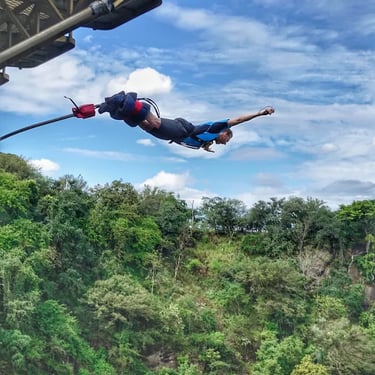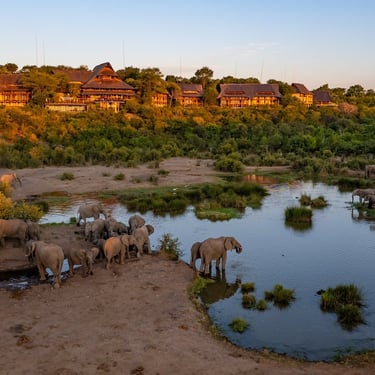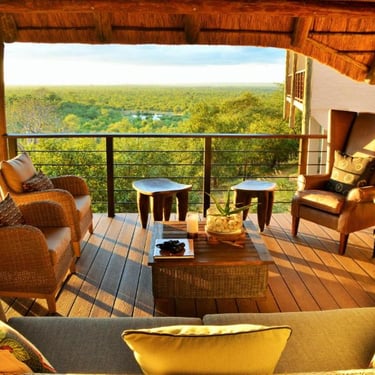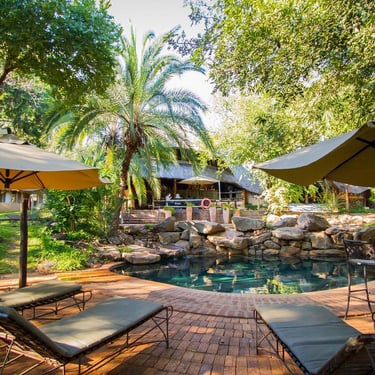Explore the Majesty of Victoria Falls: A Complete Guide
7/27/20258 min read


Introduction to Victoria Falls
Victoria Falls, known as Mosi-oa-Tunya or "The Smoke That Thunders," is one of the Seven Natural Wonders of the World, captivating visitors with its breathtaking beauty and immense presence. This magnificent waterfall, which is located on the Zambezi River, straddles the border between Zimbabwe and Zambia, creating a spectacular natural boundary that has drawn travelers from across the globe. The sheer power and majesty of Victoria Falls are awe-inspiring; during the rainy season, the volume of water cascading down the cliffs can reach an astounding 545 million liters per minute, creating a mist that can be seen from miles away.
The falls span approximately 1,708 meters in width and plunge about 108 meters, making it the largest curtain of falling water in the world. This grand display of nature not only serves as a stunning visual spectacle but also holds great cultural significance for the local communities. For centuries, indigenous tribes have revered the falls, incorporating it into their spiritual beliefs and folklore. The Zambezi River, which feeds the falls, has also been a vital resource for these communities, providing water, food, and transportation.
Victoria Falls is recognized as a UNESCO World Heritage Site, a testament to its global importance and ecological diversity. The region surrounding the falls hosts a rich variety of flora and fauna, providing habitats for endangered species and offering numerous opportunities for ecotourism. With its unique combination of natural beauty, ecological significance, and cultural heritage, Victoria Falls stands as a symbol of the breathtaking landscapes found in Africa, setting the stage for an unforgettable adventure into its depths in the following sections.
The Breathtaking Natural Beauty
Victoria Falls, one of the largest and most awe-inspiring waterfalls in the world, presents an extraordinary display of nature's magnificence. Spanning an impressive width of over a mile and plunging approximately 108 meters, this natural wonder creates a breathtaking spectacle that captivates all who visit. As the Zambezi River cascades over the precipice, the waterfall generates a mist that can be seen from miles away, further enhancing its grandeur. The thundering sound of the water, combined with the sight of millions of gallons tumbling into the gorge below, offers an unforgettable experience for travelers.
The landscape surrounding Victoria Falls is equally enchanting, characterized by lush vegetation and a rich array of biodiversity. The area is home to a variety of unique flora, including the resilient mopane trees and numerous colorful wildflowers that bloom in vibrant hues throughout the year. Similarly, the fauna of the region includes several species of birds, such as the striking African fish eagle and the elusive collared palm-thrush, as well as mammals like elephants and leopards that roam the nearby national parks. The interplay of water, land, and wildlife creates a picturesque setting that is perfect for nature enthusiasts and photographers alike.
For those keen on capturing the beauty of Victoria Falls, there are numerous prime viewpoints that offer a range of perspectives. The most popular vantage points include the Knife Edge Bridge and the Devil's Pool, where visitors can marvel at the sheer drop of the water. Sunrise and sunset are particularly magical times to visit, with the soft light illuminating the falls and casting rainbows in the mist. These photographic opportunities ensure that the majesty of Victoria Falls can be cherished long after one's visit, making it a must-see destination for all travelers.
Cultural Significance and Local Heritage
Victoria Falls holds profound cultural significance for the local communities, particularly the indigenous people who view this natural wonder as sacred. For centuries, the falls have inspired a wealth of stories, myths, and legends that reflect the values and beliefs of the local tribes such as the Ndebele and the Tonga. These narratives often center around the power of the water, which is regarded as a force of nature that embodies both life and destruction. The falls are known to the indigenous people as "Mosi-oa-Tunya," meaning "The Smoke That Thunders," a name that captures the spectacular sight and sound of the cascading water.
The historical context of Victoria Falls is steeped in exploration and discovery, dating back to its European naming by the Scottish missionary and explorer, David Livingstone, in 1855. He dedicated the name in honor of Queen Victoria, thereby intertwining the natural beauty of the falls with British colonial history. However, it is essential to recognize that the falls existed long before European explorers arrived and that the local tribes have long had a deep-rooted connection to this landmark.
Cultural practices in the regions surrounding Victoria Falls often include rituals and ceremonies that celebrate its significance. These may involve traditional music and dance during local festivals that are linked to agricultural cycles, prosperity, and ancestral worship. Communities come together during these occasions to express their gratitude for the resources and blessings the falls provide. Moreover, visitors are encouraged to engage respectfully with local customs, enriching their experience and understanding of the heritage associated with this majestic site.
Through these cultural narratives and practices, the heritage of Victoria Falls is not only preserved but also celebrated, bridging the past with the present for both local inhabitants and those who visit its breathtaking beauty.
Adventure Awaits: Activities to Enjoy
Victoria Falls is not only a breathtaking natural wonder but also a hub for adventure enthusiasts seeking thrilling experiences. Among the most exhilarating activities available are bungee jumping from the Victoria Falls Bridge, white-water rafting along the Zambezi River, and scenic helicopter tours that provide stunning aerial views of the falls.
Bungee jumping from the iconic Victoria Falls Bridge is a must-try for adrenaline junkies. Standing at 111 meters above the tumultuous Zambezi River, this jump offers an unparalleled rush as you plummet towards the water below. Safety is a top priority; participants are harnessed securely, and the jump is conducted by qualified professionals who adhere to stringent safety protocols. For those interested in this adventure, bookings can be made through local tour operators, and it’s advisable to reserve your spot in advance, particularly during peak tourist seasons.
For those who prefer to navigate the powerful waters rather than leap from heights, white-water rafting offers a different kind of excitement. The Zambezi River provides some of the best rafting experiences in the world, with rapids ranging from Grade 3 to Grade 5. This exhilarating journey takes you through stunning gorges and lush landscapes. Experienced guides lead the trips, ensuring safety while delivering an unforgettable experience. It is recommended that participants possess a moderate level of fitness and follow the information provided during pre-trip briefings.
Another way to experience the grandeur of Victoria Falls is by taking a scenic helicopter tour. These tours provide a unique vantage point, allowing you to appreciate the full scale of the waterfalls and their surrounding beauty. Flights generally last around 15 to 30 minutes, and advance booking is required due to limited availability. Each of these thrilling activities promises an adventure that captures the spirit of Victoria Falls, making it a destination every adventure seeker must consider.
When is the Best Time to Visit?
Determining the best time to visit Victoria Falls requires an understanding of the region’s climate and seasonal variations. Situated at the border of Zimbabwe and Zambia, this natural wonder experiences a subtropical climate characterized by two primary seasons: the wet and the dry season. Each season offers distinct experiences, particularly regarding the accessibility and grandeur of the waterfall.
The wet season, typically spanning from November to March, is when Victoria Falls is at its most majestic. During this period, the rainfall causes the Zambezi River to swell, resulting in spectacular water flow over the falls. The peak water levels are usually observed between February and March, making this the ideal time for visitors keen on witnessing the full force of Victoria Falls. However, be prepared for the mist that often obscures visibility, which can occasionally hinder views from certain vantage points.
Additionally, the dry season coincides with various cultural festivals that showcase local traditions and customs, enriching the travel experience. Thus, while both seasons have their unique advantages, the best time to visit Victoria Falls depends on what aspects visitors wish to witness—whether it is the thunderous roar of water or the serenely revealing landscape that characterizes the falls during the dry months.








Travel Tips for Visiting Victoria Falls
When planning a visit to Victoria Falls, it is essential to be well-prepared to ensure a smooth and enjoyable experience. Start by checking your visa requirements, as these vary depending on your nationality. Many travelers may require a visa to enter Zimbabwe or Zambia, so it is prudent to confirm this ahead of time and secure the necessary documentation prior to your journey.
Health precautions are equally important when visiting this magnificent natural wonder. Travelers should consult with a healthcare provider regarding vaccinations and medications recommended for the region. Common vaccinations include hepatitis A, hepatitis B, typhoid, and tetanus. Additionally, due to the presence of mosquitoes, it may be wise to take anti-malarial medication, especially if you plan to explore further into the areas surrounding the falls. Always pack insect repellent and consider wearing long-sleeved clothing in the evenings to reduce exposure.
As you prepare your itinerary, be mindful of the various activities you plan to undertake, such as hiking, zip-lining, or boat trips. Ensure you equip yourself with appropriate gear, including lightweight moisture-wicking clothing, sturdy hiking shoes, and a waterproof camera bag. For those seeking adventure, don’t forget to bring swimwear for any water-based activities.
Transportation options to and around Victoria Falls are also important to consider. Visitors can choose from various means, such as taxis, shuttle services, or rental cars. Local buses are available and provide an economical option, although they may not be the most comfortable method. It's advisable to arrange transportation in advance to avoid discomfort on the day of your visit.
Lastly, understanding local customs and etiquette is crucial for a respectful experience. For instance, greeting locals with a polite "hello" and showing appreciation for their culture can foster positive interactions. Observing the local dress code, especially in sacred areas, is also recommended. Through these guidelines, you can ensure your trip to Victoria Falls is both respectful and memorable.
Conclusion: Your Next Adventure Awaits!
As you contemplate your next travel destination, Victoria Falls emerges as an unparalleled choice that promises to provide unforgettable experiences. This magnificent natural wonder, straddling the border between Zambia and Zimbabwe, captivates visitors with its breathtaking views, making it an essential stop for any adventurous traveler. The sheer scale and beauty of the falls are enough to leave one in awe, and the surrounding landscape offers countless opportunities for exploration and adventure.
At Victoria Falls, the thrill-seeker will find a myriad of exciting activities. From white-water rafting on the Zambezi River to bungee jumping off the iconic cliffs, there is no shortage of adrenaline-pumping experiences. For those seeking a more tranquil experience, leisurely boat cruises offer a chance to soak in the serene beauty of the falls while spotting diverse wildlife along the riverbanks. The walking trails around Victoria Falls are equally enticing, presenting an opportunity to witness the lush flora and impressive geological formations up close.
In addition to the natural beauty and thrilling adventures, the rich culture and history of the region provide another layer of experience for visitors. Engaging with local communities and discovering their traditions will enrich your understanding of this extraordinary destination. Furthermore, witnessing the Falls at different times of the year allows you to appreciate unique perspectives, as the water flow varies dramatically, enhancing the visual spectacle.
Victoria Falls is more than just a destination; it is a unique journey into one of the world’s greatest natural wonders. Whether your interests lean toward adventure, relaxation, or cultural immersion, this remarkable location promises a memorable experience. It is time to pack your bags, set your sights on Victoria Falls, and embark on an adventure filled with wonder and discovery.
